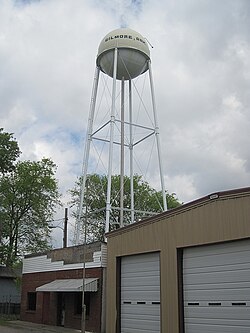Gilmore, Arkansas
Gilmore, Arkansas | |
|---|---|
 | |
 Location of Gilmore in Crittenden County, Arkansas. | |
| Coordinates: 35°24′40″N 90°16′39″W / 35.41111°N 90.27750°WCoordinates: 35°24′40″N 90°16′39″W / 35.41111°N 90.27750°W | |
| Country | United States |
| State | Arkansas |
| County | Crittenden |
| Area | |
| • Total | 13.54 sq mi (35.07 km2) |
| • Land | 13.52 sq mi (35.01 km2) |
| • Water | 0.03 sq mi (0.07 km2) |
| Elevation | 226 ft (69 m) |
| Population (2010) | |
| • Total | 188 |
| • Estimate (2019)[2] | 246 |
| • Density | 18.20/sq mi (7.03/km2) |
| Time zone | UTC-6 (Central (CST)) |
| • Summer (DST) | UTC-5 (CDT) |
| ZIP code | 72339 |
| Area code(s) | 870 |
| FIPS code | 05-27040 |
| GNIS feature ID | 0057817 |
Gilmore is a city in Crittenden County, Arkansas, United States. The population was 263 at the 2010 census.[3]
Geography[]
Gilmore is located in northern Crittenden County at 35°24′40″N 90°16′39″W / 35.41111°N 90.27750°W (35.411229, -90.277528).[4] It is bordered to the south by the city of Turrell. Interstate 555 (as well as U.S. Routes 61 and 63) pass through the west part of Gilmore, leading northwest 44 miles (71 km) to Jonesboro and south 20 miles (32 km) via Interstate 55 to West Memphis. According to the United States Census Bureau, Gilmore has a total area of 0.23 square miles (0.6 km2), all land.[3]
Ecologically, Gilmore is located within the Northern Backswamps ecoregion within the larger Mississippi Alluvial Plain. The Northern Backswamps are a network of low-lying overflow areas and floodplains historically dominated by bald cypress, water tupelo, overcup oak, water hickory, and Nuttall oak forest subject to year-round or seasonal inundation.[5] The Wapanocca National Wildlife Refuge, which preserves some of the year-round flooded bald cypress forest typical of this ecoregion prior to development for row agriculture lies southeast of Gilmore.
Demographics[]
| Historical population | |||
|---|---|---|---|
| Census | Pop. | %± | |
| 1960 | 438 | — | |
| 1970 | 461 | 5.3% | |
| 1980 | 503 | 9.1% | |
| 1990 | 331 | −34.2% | |
| 2000 | 292 | −11.8% | |
| 2010 | 188 | −35.6% | |
| 2019 (est.) | 246 | [2] | 30.9% |
| U.S. Decennial Census[6] 2014 Estimate[7] | |||
As of the census[8] of 2000, there were 292 people, 100 households, and 78 families residing in the town. The population density was 512.5/km2 (1,306.1/mi2). There were 114 housing units at an average density of 200.1/km2 (509.9/mi2). The racial makeup of the town was 19.86% White, 79.11% Black or African American, 0.68% from other races, and 0.34% from two or more races.
There were 100 households, out of which 38.0% had children under the age of 18 living with them, 43.0% were married couples living together, 31.0% had a female householder with no husband present, and 22.0% were non-families. 22.0% of all households were made up of individuals, and 8.0% had someone living alone who was 65 years of age or older. The average household size was 2.92 and the average family size was 3.38.
In the town the population was spread out, with 35.3% under the age of 18, 9.9% from 18 to 24, 24.3% from 25 to 44, 19.9% from 45 to 64, and 10.6% who were 65 years of age or older. The median age was 30 years. For every 100 females, there were 105.6 males. For every 100 females age 18 and over, there were 83.5 males.
The median income for a household in the town was $20,625, and the median income for a family was $22,031. Males had a median income of $29,375 versus $18,000 for females. The per capita income for the town was $8,867. About 29.1% of families and 38.6% of the population were below the poverty line, including 52.2% of those under the age of eighteen and 44.8% of those 65 or over.
References[]
| Wikimedia Commons has media related to Gilmore, Arkansas. |
- ^ "2019 U.S. Gazetteer Files". United States Census Bureau. Retrieved June 30, 2020.
- ^ Jump up to: a b "Population and Housing Unit Estimates". United States Census Bureau. May 24, 2020. Retrieved May 27, 2020.
- ^ Jump up to: a b "Geographic Identifiers: 2010 Demographic Profile Data (G001): Gilmore city, Arkansas". U.S. Census Bureau, American Factfinder. Archived from the original on February 12, 2020. Retrieved June 20, 2014.
- ^ "US Gazetteer files: 2010, 2000, and 1990". United States Census Bureau. 2011-02-12. Retrieved 2011-04-23.
- ^
 This article incorporates public domain material from the United States Geological Survey document: Woods, A.J., Foti, T.L., Chapman, S.S., Omernik, J.M.; et al. "Ecoregions of Arkansas" (PDF).CS1 maint: multiple names: authors list (link) (color poster with map, descriptive text, summary tables, and photographs)
This article incorporates public domain material from the United States Geological Survey document: Woods, A.J., Foti, T.L., Chapman, S.S., Omernik, J.M.; et al. "Ecoregions of Arkansas" (PDF).CS1 maint: multiple names: authors list (link) (color poster with map, descriptive text, summary tables, and photographs)
- ^ "Census of Population and Housing". Census.gov. Retrieved June 4, 2015.
- ^ "Annual Estimates of the Resident Population for Incorporated Places: April 1, 2010 to July 1, 2015". Archived from the original on May 22, 2015. Retrieved June 22, 2016.
- ^ "U.S. Census website". United States Census Bureau. Retrieved 2008-01-31.
External links[]
- Cities in Crittenden County, Arkansas
- Cities in Arkansas
- Memphis metropolitan area

